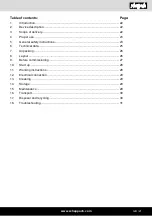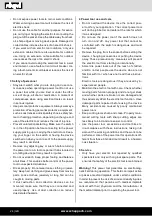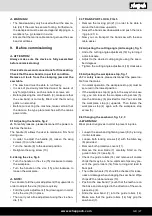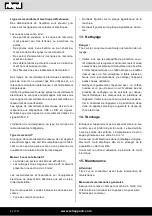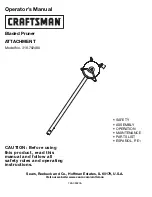
www.scheppach.com
GB | 27
9.3 TRANSPORT LOCK, FIG. 5
• Remove the locking pin (21) in order to be able to
swivel the band saw upwards.
• Swivel the band saw downwards and push the lock-
ing pin (21) in.
•
Now you can transport the band saw with the saw
table easier.
9.4
Adjusting the cutting angle (mitre angle), fig. 5
•
Undo the cutting angle adjustment (18) by turning it
anti-clockwise.
•
Adjust to the desired cutting angle using the speci
-
fied degrees.
•
Tighten the cutting angle adjustment (18) clockwise.
9.5 Adjusting the workpiece stop, fig. 1
m
For safety reasons, please disconnect the power ca
-
ble from the mains.
• In normal operation, the workpiece stop (4) must be
secured in the lowest position.
•
If the workpiece stop (4) gets in the way when saw
-
ing, you can loosen the workpiece stop screw (5).
Use the Allen key (6) provided for this.
You can slide
the workpiece stop (4) upwards. Then fasten the
workpiece stop (4) again with the workpiece stop
screw (5).
9.6 Changing the saw band, fig. 1, 2, 3
m
WARNING!
Wear protective gloves in order to prevent injuries.
•
Loosen the saw band tightening lever (8) by turning
it anti-clockwise.
•
Loosen both locking screws (12) with the Allen key
(6) provided.
• Remove both protective covers (11).
•
Remove the saw blade (7) carefully.
Start on the
guide rollers (14) (see fig. 3).
• Check the guide rollers (14) and remove all coarse
chips that may be in here.
Jammed chips may pre
-
vent the guide rollers (14) from turning and lead to
flat spots.
• The rubber wheels (13) should be checked for loose-
ness or damage when changing the saw band. Wipe
chips off the rubber wheels (13).
• Position the saw band (7) such that the teeth are on
the base and are angled in the direction of the work-
piece stop (4).
• Slide the saw band (7) into the guide rollers (14).
Make sure that the guide rollers (14) fully grip the
saw band (7).
m
WARNING!
•
The band saw may only be used without the saw ta
-
ble (24) if the user has secure footing. Furthermore,
the workpiece must be secured against slipping on a
workbench, e.g. clamped in a vice.
• Ensure that the mains cable cannot get near the saw
band at all times.
9. Before commissioning
m
ATTENTION!
Always make sure the device is fully assembled
before commissioning!
Check all screws and connections for firm seating.
Check that the saw band is in perfect condition.
Remove all tools from the clamping jaw and the
saw table.
•
The saw band must be able to run freely.
•
In case of previously machined wood, be aware of
any foreign bodies, such as nails or screws, etc.
•
Before pressing the on/off switch (3), make sure that
the saw band is correctly fitted, and that moving
parts run smoothly.
• Before connecting the machine, make certain that
the data on the type plate matches with the mains
power data.
9.1 Adjusting the handle, fig. 2
m
For safety reasons, please disconnect the power ca
-
ble from the mains.
The handle (9) allows the user to maintain a firm hold
during use.
•
In order to adjust the handle (9), loosen the wing
screws (10) on the handle.
• Turn the handle (9) to the desired position.
• Retighten the wing screw (10).
9.2 Using the vice, fig. 6
• Turn the handle on the vice (15) clockwise to clamp
the workpiece.
• Turn the handle on the vice (15) anti-clockwise to
loosen the workpiece.
m
NOTE!
You can also fold the quick adjustment (15a) upwards in
order to adjust the vice (16) more quickly.
•
Fold the quick adjustment (15a) down again in order
to fix the vice (16) in place.
•
Then carry out a fine adjustment using the vice han
-
dle (15).
Summary of Contents for 5901511901
Page 2: ...www scheppach com 2 1 5 1 2 3 4 6 7 8 ...
Page 3: ...www scheppach com 3 2 3 4 9 10 11 12 15a 15 16 17 13 14 ...
Page 4: ...www scheppach com 4 5 18 19 20 21a 21 22 6 23 24 25 22 19 26 24 A B C 15 15a 16 7 ...
Page 243: ...www scheppach com 243 ...
Page 244: ...www scheppach com 244 ...
Page 248: ...www scheppach com 248 ...
Page 252: ...www scheppach com 252 ...









